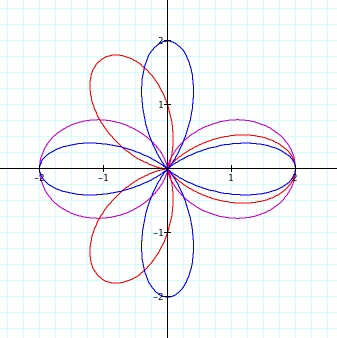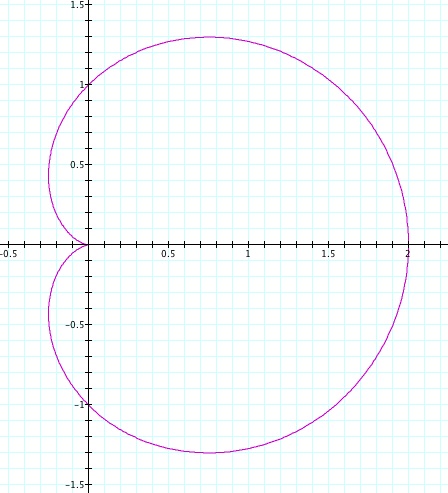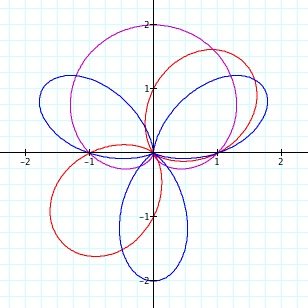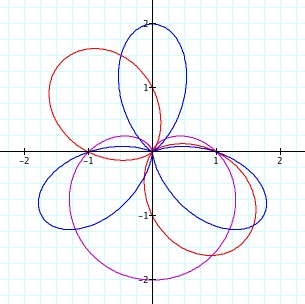

We will begin by exploring functions of the form: ![]() where a = b and k is an integer.
where a = b and k is an integer.
k = 0 is a trivial case because when k = 0, r does not depend on ![]() . We simply get that r = a + b for all
. We simply get that r = a + b for all ![]() .
.
We will now look at what happens when k is a positive integer. We will begin with the case when k = 2 and return later to the case when k = 1:
a = b = 1 in purple; a = b = 2 in red; a = b = 3 in blue

As you can see, increasing the values of a and b simply stretch the image by a factor of whatever number they are set to. This means that a = b = 2 will be twice as big as a = b = 1; a = b = 3 will be three times as big as a = b = 1; etc. This is true for all k because ![]() whenever a = b. Therefore, to understand functions of this type, we need only look a the case when a = b = 1.
whenever a = b. Therefore, to understand functions of this type, we need only look a the case when a = b = 1.
Next, we will look at what happens when we increase the size of k:
k = 2 in pup le; k = 3 in red; k = 4 in blue

From the image, we can see that for k ![]() 2, we get an image similar to a rose with exactly k leaves. The center of the rose is always at the origin, and the ends of the rose petals are always a distance of 2a from the origin. As the number of petals increase, the space between them decrease proportionally. The tip of the first petal will always be at (2a, 0), and each new petal will be a rotation of the first petal by a measure of
2, we get an image similar to a rose with exactly k leaves. The center of the rose is always at the origin, and the ends of the rose petals are always a distance of 2a from the origin. As the number of petals increase, the space between them decrease proportionally. The tip of the first petal will always be at (2a, 0), and each new petal will be a rotation of the first petal by a measure of ![]() degrees. The reason for this is because the cosine function is cyclic, and increasing k simply increases the rate at which the cosine function moves through its cycle by a factor of k.
degrees. The reason for this is because the cosine function is cyclic, and increasing k simply increases the rate at which the cosine function moves through its cycle by a factor of k.
k = 1, however, is an interesting case:

k = 1 is the only positive integer al value for k that does not resemble rose petals. This is because when cos(![]() ) gives us negative values, they are always greater than or equal to -1. When we add 1 to whatever value we get, we always get a positive number except when
) gives us negative values, they are always greater than or equal to -1. When we add 1 to whatever value we get, we always get a positive number except when ![]() = 180 degrees, we get 0. This gives us a shape that does not have rotational symmetry, and acts differently on the right side of the y-axis than it does on the left side of the y-axis.
= 180 degrees, we get 0. This gives us a shape that does not have rotational symmetry, and acts differently on the right side of the y-axis than it does on the left side of the y-axis.
When is negative, we get the exact same functions that we did when k was positive:
k = -1 in purple; k = -2 in red; k = -3 in blue

The reason for this is because all of our functions are symmetric about the x-axis. Therefore, when we draw our graphs starting at (2a,0) and move clockwise instead of counter-clockwise, we still get all of the same graphs. This is all that is happening when we make k negative, so it does not change our graphs in this case.
We will now look at some graphs of the form: ![]() where a = b and k is a positive integer. Here are a few such graphs:
where a = b and k is a positive integer. Here are a few such graphs:
k = 1 in purple; k = 2 in red; k = 3 in blue

As you can see, the graphs of this type are the same as the graphs of the form ![]() with a simple rotation applied. However, the rotation is not a constant amount for every k. In fact, it is a rotation by exactly
with a simple rotation applied. However, the rotation is not a constant amount for every k. In fact, it is a rotation by exactly ![]() degrees counterclockwise. This means that the greater the value of k, the less the function is rotated. The reason for this is that the sine function is a rotation of the cosine function by 90 degrees. Since when we change the value of k, we change the speed at which the function runs through its cycle, this rotation decreases as k increases.
degrees counterclockwise. This means that the greater the value of k, the less the function is rotated. The reason for this is that the sine function is a rotation of the cosine function by 90 degrees. Since when we change the value of k, we change the speed at which the function runs through its cycle, this rotation decreases as k increases.
We can also look at functions of the form ![]() when a = b and k is a negative integer. Here are a few such graphs:
when a = b and k is a negative integer. Here are a few such graphs:
k = -1 in purple; k = -2 in red; k = -3 in blue

This case is similar to the case when k was positive, except that instead of rotating the graphs of the form ![]() by
by ![]() degrees counter-clockwise, we rotate them by |
degrees counter-clockwise, we rotate them by |![]() | degrees clockwise. This is because when we make the value of k negative, we make the value of
| degrees clockwise. This is because when we make the value of k negative, we make the value of ![]() negative, which causes it move in the opposite direction that it normally does.
negative, which causes it move in the opposite direction that it normally does.
When k = 0, functions of the form ![]() are always a circle with radius a because setting k = 0 sets the sine function equal to zero, which always gives us a value of 0.
are always a circle with radius a because setting k = 0 sets the sine function equal to zero, which always gives us a value of 0.